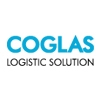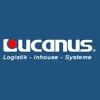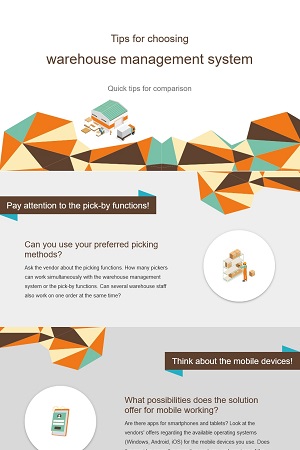 Synko BarScan ist die Scannerlösung zur Erfassung, Kontrolle und Etikettierung Ihrer Warenbestände. Die Software ist vollständig in Microsoft Dynamics 365 Business Central (Microsoft Dynamics NAV, Navision) integriert. Mit synko BarScan erfassen Ihre Mitarbeiter alle Warenbewegungen mit mobilen Scannern. Das betrifft die Tätigkeiten im Wareneingang, bei der Einlagerung und Umlagerung sowie Umpackvorgänge und Auspackvorgänge, die Kommissionierung, den Warenausgang und die Inventur.
Synko BarScan ist die Scannerlösung zur Erfassung, Kontrolle und Etikettierung Ihrer Warenbestände. Die Software ist vollständig in Microsoft Dynamics 365 Business Central (Microsoft Dynamics NAV, Navision) integriert. Mit synko BarScan erfassen Ihre Mitarbeiter alle Warenbewegungen mit mobilen Scannern. Das betrifft die Tätigkeiten im Wareneingang, bei der Einlagerung und Umlagerung sowie Umpackvorgänge und Auspackvorgänge, die Kommissionierung, den Warenausgang und die Inventur. SPEEDLOGIX is a flexible warehouse management software that already integrates numerous process maps as standard and can be quickly adapted to customer-specific requirements thanks to its modular design. Thanks to its standardized structure, speedLOGIX is ready for use very quickly. The solution supports modern picking processes such as MDEs, pick-by-voice, pick-by-light, etc. SPEEDLOGIX supports completely paperless processing.
SPEEDLOGIX is a flexible warehouse management software that already integrates numerous process maps as standard and can be quickly adapted to customer-specific requirements thanks to its modular design. Thanks to its standardized structure, speedLOGIX is ready for use very quickly. The solution supports modern picking processes such as MDEs, pick-by-voice, pick-by-light, etc. SPEEDLOGIX supports completely paperless processing. SuPCIS-L is a flexible and powerful warehouse management software for use in logistics solutions of all sizes and at all levels of automation. The WMS supports you in your intralogistics processes. SuPCIS includes all the functionalities you need to map your logistics processes. The material flow computer can also be used to integrate conveyor technology or a forklift control system, for example, regardless of the manufacturer.
SuPCIS-L is a flexible and powerful warehouse management software for use in logistics solutions of all sizes and at all levels of automation. The WMS supports you in your intralogistics processes. SuPCIS includes all the functionalities you need to map your logistics processes. The material flow computer can also be used to integrate conveyor technology or a forklift control system, for example, regardless of the manufacturer. BetterTec Solutions is a professional warehouse management system that enables scanner-supported storage and retrieval processes. The goods can be transferred to the consignment warehouse without intermediate storage. Using the BetterStore application, the employee scans the barcode of the storage location and the data is transferred to the BetterBase database. Stock management can be organized according to FIFO principles. Stock transfers, stock checks and inventory results can be forwarded to third-party systems.
BetterTec Solutions is a professional warehouse management system that enables scanner-supported storage and retrieval processes. The goods can be transferred to the consignment warehouse without intermediate storage. Using the BetterStore application, the employee scans the barcode of the storage location and the data is transferred to the BetterBase database. Stock management can be organized according to FIFO principles. Stock transfers, stock checks and inventory results can be forwarded to third-party systems. PROLAG®World is a fully comprehensive software solution for all logistics requirements. The software can be individually configured and is quickly ready for use. PROLAG®World is used globally as a web-based warehouse management system by distribution and storage centers, production facilities, hazardous materials warehouses and shipping centers. Around 150 modules are available for customization to meet your requirements. The solution can also be used on-premises.
PROLAG®World is a fully comprehensive software solution for all logistics requirements. The software can be individually configured and is quickly ready for use. PROLAG®World is used globally as a web-based warehouse management system by distribution and storage centers, production facilities, hazardous materials warehouses and shipping centers. Around 150 modules are available for customization to meet your requirements. The solution can also be used on-premises. COGLAS Web WMS - Modern. Flexible. Future-proof - The COGLAS warehouse management software is designed according to the modular principle. The modern and easy to use WMS makes your logistics transparent and fast. Monitor your stock levels efficiently and control goods movements via a central cockpit. Use the practical quality assurance functions and increase the reliability and speed of your logistics processes.
COGLAS Web WMS - Modern. Flexible. Future-proof - The COGLAS warehouse management software is designed according to the modular principle. The modern and easy to use WMS makes your logistics transparent and fast. Monitor your stock levels efficiently and control goods movements via a central cockpit. Use the practical quality assurance functions and increase the reliability and speed of your logistics processes. PSIwms is a flexible and proven warehouse management system. It enables the transparent and efficient design and mapping of your warehouse and logistics processes. Already in the standard version, our Warehouse Management System (WMS) supports all relevant warehouse forms, types and technologies. It can be used in production-related warehouses as well as in shipping warehouses or distribution centers. The WMS is suitable for small to large and complex warehouses, turning a WMS into an intelligent warehouse management system.
PSIwms is a flexible and proven warehouse management system. It enables the transparent and efficient design and mapping of your warehouse and logistics processes. Already in the standard version, our Warehouse Management System (WMS) supports all relevant warehouse forms, types and technologies. It can be used in production-related warehouses as well as in shipping warehouses or distribution centers. The WMS is suitable for small to large and complex warehouses, turning a WMS into an intelligent warehouse management system. GISMO is designed for use in intra-logistics. It is used for paperless inventory and the tracking and media-supported management of fixed assets. Extensive analysis functions are available. The software can be used, for example, to manage unique items such as document archives or to track chemicals. The flexible architecture can be adapted to customer requirements.
GISMO is designed for use in intra-logistics. It is used for paperless inventory and the tracking and media-supported management of fixed assets. Extensive analysis functions are available. The software can be used, for example, to manage unique items such as document archives or to track chemicals. The flexible architecture can be adapted to customer requirements. LogoS includes all functions for a document-controlled warehouse for any number of clients, putaway customers, storage locations and storage bins. The software has a modular design and can be easily extended. Order management for goods receipts, goods issues and stock transfers are mapped as well as automatic storage location allocation and comprehensive inventory management including statistics tools. Different parameterizable storage strategies are supported.
LogoS includes all functions for a document-controlled warehouse for any number of clients, putaway customers, storage locations and storage bins. The software has a modular design and can be easily extended. Order management for goods receipts, goods issues and stock transfers are mapped as well as automatic storage location allocation and comprehensive inventory management including statistics tools. Different parameterizable storage strategies are supported. The GFOS.Smart Manufacturing software solution is a perfect tool for production control and warehouse management. It supports transparency and optimized processes in large companies and manufacturing operations, thus streamlining production. The MES software has a modular structure. It can easily be used as a basic version and expanded as required.
The GFOS.Smart Manufacturing software solution is a perfect tool for production control and warehouse management. It supports transparency and optimized processes in large companies and manufacturing operations, thus streamlining production. The MES software has a modular structure. It can easily be used as a basic version and expanded as required. Die webbasierte twoeyes enterprise Warenwirtschaft eröffnet Ihnen eine Vielzahl an neuer Chancen und Möglichkeiten. Managen Sie sämtliche Waren und Artikel auf Basis präziser Stammdaten und mit einem äußerst professionellen Auftrags-, Lager- und Versandwesen. Optimieren Sie Ihre Produktion nach Kanban und/oder individuellen QM-Vorgaben. Definieren Sie Ihre Preise, Preisgruppen und Staffelpreise, planen Sie Sonderverkaufsaktionen und verknüpfen Sie die Wawi mit Ihrem Online-Shop.
Die webbasierte twoeyes enterprise Warenwirtschaft eröffnet Ihnen eine Vielzahl an neuer Chancen und Möglichkeiten. Managen Sie sämtliche Waren und Artikel auf Basis präziser Stammdaten und mit einem äußerst professionellen Auftrags-, Lager- und Versandwesen. Optimieren Sie Ihre Produktion nach Kanban und/oder individuellen QM-Vorgaben. Definieren Sie Ihre Preise, Preisgruppen und Staffelpreise, planen Sie Sonderverkaufsaktionen und verknüpfen Sie die Wawi mit Ihrem Online-Shop. Doll + Leiber TMS is a software for warehouse management with which you can offer your customers a plus in logistics service. In any type of warehouse (block warehouse, shelf warehouse, chaotic warehouse) you have the utilization perfectly in view. After entering extensive labeling, you manage batches, serial numbers and articles with minimum shelf life. The solution can be extended by barcode processing and then also maps the permanent inventory.
Doll + Leiber TMS is a software for warehouse management with which you can offer your customers a plus in logistics service. In any type of warehouse (block warehouse, shelf warehouse, chaotic warehouse) you have the utilization perfectly in view. After entering extensive labeling, you manage batches, serial numbers and articles with minimum shelf life. The solution can be extended by barcode processing and then also maps the permanent inventory. PalOPTI® is the innovative solution for optimizing storage space and achieving packaging efficiency! With palOPTI® you can calculate packaging sizes precisely to make maximum use of every centimeter of storage space. The palletizing software analyses and arranges homogeneous round and square packages and outer cartons in rectangular container types such as pallets, mesh boxes or trucks. With palOPTI® you always have full control over your packaging processes and enables you to achieve the greatest possible efficiency and cost savings ...
PalOPTI® is the innovative solution for optimizing storage space and achieving packaging efficiency! With palOPTI® you can calculate packaging sizes precisely to make maximum use of every centimeter of storage space. The palletizing software analyses and arranges homogeneous round and square packages and outer cartons in rectangular container types such as pallets, mesh boxes or trucks. With palOPTI® you always have full control over your packaging processes and enables you to achieve the greatest possible efficiency and cost savings ... Optimal warehouse management is an important foundation for successful business management. MiCLAS. offers you not only the classic disposition procedures, but also methods of strictly order-based planning. Of course, the software includes serial number management and batch-oriented inventory management. Inventories are also facilitated and simplified. For example, you can map permanent inventories or key date inventories.
Optimal warehouse management is an important foundation for successful business management. MiCLAS. offers you not only the classic disposition procedures, but also methods of strictly order-based planning. Of course, the software includes serial number management and batch-oriented inventory management. Inventories are also facilitated and simplified. For example, you can map permanent inventories or key date inventories. Tool dispensing and management is optimally supported by our tool management module. There are a wide range of variants, from dispensing by a magazine to independent lending by employees. Automatic tool systems, key cabinets or vertical lift systems can be included. Handover at the construction site is also possible via the mobile app. You have a complete overview of your tools, equipment and materials.
Tool dispensing and management is optimally supported by our tool management module. There are a wide range of variants, from dispensing by a magazine to independent lending by employees. Automatic tool systems, key cabinets or vertical lift systems can be included. Handover at the construction site is also possible via the mobile app. You have a complete overview of your tools, equipment and materials.